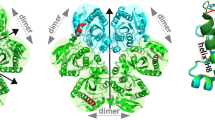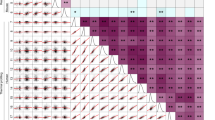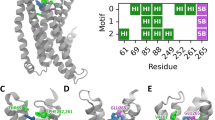Abstract
Conformational changes that gate the access of substrates or ligands to an active site are important features of enzyme function. In this report, we describe an unusual example of a structural rearrangement near a buried artificial cavity in cytochrome cperoxidase that occurs on binding protonated benzimidazole. A hinged main-chain rotation at two residues (Pro 190 and Asn 195) results in a surface loop rearrangement that opens a large solvent-accessible channel for the entry of ligands to an otherwise inaccessible binding site. The trapping of this alternate conformational state provides a unique view of the extent to which protein dynamics can allow small molecule penetration into buried protein cavities.
This is a preview of subscription content, access via your institution
Access options
Subscribe to this journal
Receive 12 print issues and online access
$259.00 per year
only $21.58 per issue
Buy this article
- Purchase on SpringerLink
- Instant access to full article PDF
Prices may be subject to local taxes which are calculated during checkout
Similar content being viewed by others
References
Li, L.Y., Falzone, C.J., Wright, P.E. & Benkovic, S.J. Functional role of a mobile loop of Escherichia coli dihydrofolate reductase in transition-state stabilization. Biochemistry 31, 7826–7833 (1992).
Sampson, N.S. & Knowles, J.R. Segmental movement - definition of the structural requirements for loop closure in catalysis by triosephosphate isomerase. Biochemistry 31, 8482–8487 (1992).
Li, H. & Poulos, T.L. Modeling protein-substrate interactions in the heme domain of cytochrome P450BM-3. Acta Cryst. D51, 21–32 (1995).
Nobbs, C.L. Heme and Hemoproteins 1, 143–147 (Academic Press, New York, 1966).
Jaskolski, M. et al. Structure at 2.5 Å resolution of chemically synthesized human immunodeficiency virus type I protease complexed with a hydroxyethylene-based inhibitor. Biochemistry 30, 1600–1609 (1991).
Rao, J.K.M., Erickson, J.W. & Wlodawer, A. Structural and evolutionary relationship between retroviral and eucaryotic aspartic proteinases. Biochemistry 30, 4663–4671 (1991).
Koshland, D.E. Application of a theory of enzyme specificity to protein synthesis. Proc. Natl. Acad. Sci. USA 44, 98–104 (1958).
Herschlag, D. The role of induced fit and conformational changes of enzymes in specificity and catalysis. Bioorg. Chem. 16, 62–96 (1988).
Williams, J.C. & McDermott, A.E. Dynamics of the flexible loop of triosephosphate isomerase: the loop motion is not ligand gated. Biochemistry 34, 8309–9319 (1995).
Falzone, C.J., Wright, P.E. & Benkovic, S.J. Dynamics of a flexible loop in dihydrofolate reductase from Escherichia coli and its implication for catalysis Biochemistry. 33, 439–442 (1994).
Young, R.D. et al. Time- and temperature dependence of large-scale conformational transitions in myoglobin. Chemical Physics 158, 315–327 (1991).
Frauenfelder, H. & Wolynes, P.G. Rate theories and puzzles of hemeprotein kinetics. Science 229, 337–345 (1985).
Frauenfelder, H., Sligar, S.G. & Wolynes, P.G. The energy landscapes and motions of proteins. Science 254, 1598–1603 (1991).
Beece, D. et al. Solvent viscosity and protein dynamics. Biochemistry 19, 5147–5157 (1980).
Eriksson, A.E. et al. Response of a protein structure to cavity-creating mutations and its relation to the hydrophobic effect. Science 255, 178–183 (1992).
Eriksson, A.E., Baase, W.A., Wozniak, J.A. & Matthews, B.W. A cavity-containing mutant of T4 lysozyme is stabilized by buried benzene. Nature 355, 371–373 (1992).
Eriksson, A.E., Baase, W.A. & Matthews, B.W. Similar hydrophobic replacements of Leu99 and Phe153 within the core of T4-lysozyme have different structural and thermodynamic consequences. J. Mol. Biol. 229, 747–769 (1993).
Fitzgerald, M.M., Churchill, M.J., McRee, D.E. & Goodin, D.B. Small molecule binding to an artificially created cavity at the active site of cytochrome c peroxidase. Biochemistry 33, 3807–3818 (1994).
Erman, J.E., Vitello, L.B., Mauro, J.M. & Kraut, J. Detection of an oxyferryl porphyrin π-cation-radical intermediate in the reaction between hydrogen peroxide and a mutant yeast cytochrome c peroxidase. Evidence for tryptophan-191 involvement in the radical site of compound I. Biochemistry 28, 7992–5 (1989).
Scholes, C.P. et al. Recent ENDOR and pulsed electron paramagnetic resonance studies of cytochrome c peroxidase-compound I and its site-directed mutants Isr. J. Chem 29, 85–92 (1989).
Sivaraja, M., Goodin, D.B., Smith, M. & Hoffman, B.M. Identification by ENDOR of Trp191 as the free-radical site in cytochrome c peroxidase compound ES. Science 245, 738–740 (1989).
Houseman, A.L.P., Doan, P.E., Goodin, D.B. & Hoffman, B.M. Comprehensive explanation of the anomalous EPR spectra of wild-type and mutant cytochrome-c peroxidase compound-ES. Biochemistry 32, 4430–4443 (1993).
Huyett, J.E. et al. Compound ES of cytochrome c peroxidase contains a Trp π-cation radical: characterization by CW and pulsed Q-band ENDOR spectroscopy. J. Am. Chem. Soc. 117, 9033–9041 (1995).
Jensen, G.M., Goodin, D.B. & Bunte, S.W. Density functional and MP2 calculations of spin densities of oxidized 3-methyl indole: models for tryptophan radicals. J. Phys. Chem. 100, 954–959 (1996).
Miller, M.A., Han, G.W. & Kraut, J. A Cation binding motif stabilizes the compound I radical of cytochrome c peroxidase. Proc. Natl. Acad. Sci. USA 91, 11118–11122 (1994).
Fitzgerald, M.M., Trester, M.L., Jensen, G.M., McRee, D.E. & Goodin, D.B. The role of aspartate-235 in the binding of cations to an artificial cavity at the radical site of cytochrome c peroxidase. Protein Science 4, 1844–1850 (1995).
Richardson, J.S. & Richardson, D.C. Amino acid preferences for specific locations at the ends of α helices. Science 240, 1648–1652 (1988).
Edwards, S.L., Kraut, J. & Poulos, T.L. Crystal structure of nitric oxide inhibited cytochrome c peroxidase. Biochemistry 27, 8074–8175 (1988).
Picot, D., Loll, P.J. & Garavito, R.M. The X-ray crystal structure of the membrane protein prostaglandin H2 synthase-1. Nature 367, 243–249 (1994).
Koide, S., Dyson, H.J. & Wright, P.E. Characterization of a folding intermediate of apoplastocyanin trapped by proline isomerization. Biochemistry 32, 12299–12310 (1993).
McRee, D.E. A Visual protein crystallographic software system for X11/Xview. J. Mol. Graphics 10, 44–46 (1992).
Brünger, A.T. & Karplus, M. Crystallographic R-factor refinement by molecular dynamics. Science 235, 458–460 (1987).
Connolly, M.L. Solvent accessible surfaces of proteins and nucleic acids. Science 221, 709–713 (1983).
Author information
Authors and Affiliations
Rights and permissions
About this article
Cite this article
Fitzgerald, M., Musah, R., McRee, D. et al. A ligand-gated, hinged loop rearrangement opens a channel to a buried artificial protein cavity. Nat Struct Mol Biol 3, 626–631 (1996). https://doi.org/10.1038/nsb0796-626
Received:
Accepted:
Issue date:
DOI: https://doi.org/10.1038/nsb0796-626
This article is cited by
-
Impact of proximal and distal pocket site-directed mutations on the ferric/ferrous heme redox potential of yeast cytochrome c peroxidase
Theoretical Chemistry Accounts (2011)
-
An improved relaxed complex scheme for receptor flexibility in computer-aided drug design
Journal of Computer-Aided Molecular Design (2008)
-
Outliers in SAR and QSAR: Is unusual binding mode a possible source of outliers?
Journal of Computer-Aided Molecular Design (2007)
-
Not just your average structures
Nature Structural Biology (1996)



